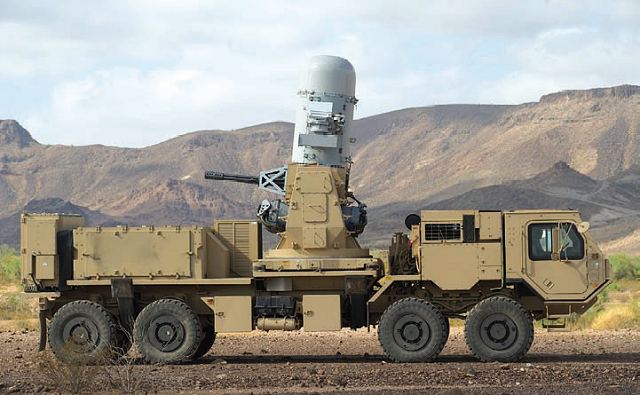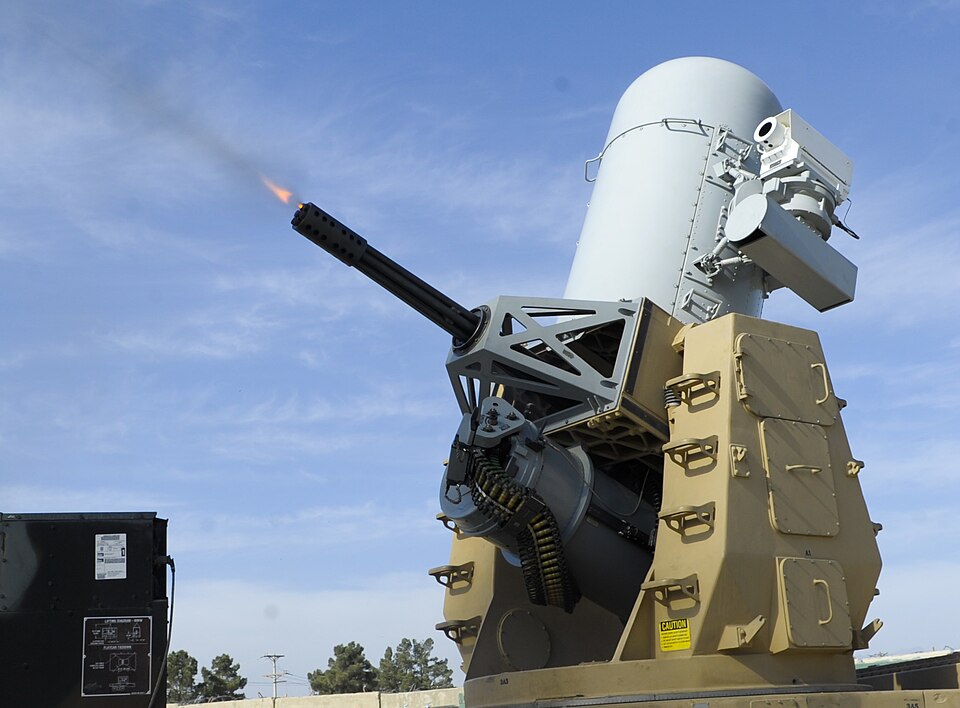The Centurion C-RAM, also called the Land Phalanx Weapon System (LPWS), is an American Counter-Rocket, Artillery, and Mortar (C-RAM) air defense artillery system. The system was developed in 2004, during and after the Iraq War identified a weakness in ground-based anti-projectile artillery. The system is produced by Northrop Grumman, Raytheon, and Oshkosh Corporation and is deployed on a trailer or more generally on the Oshkosh Heavy Expanded Mobility Tactical Truck (HEMTT) with an integrated generator and cooling system.
Development

The Centurion RAM “Counter Rocket, Artillery, and Mortar” was developed as an Indirect Fire Protection Capability (IFPC) weapons system and produced by Northrop Grumman with Raytheon as a weapon system, to be based on the Oshkosh Corporation
HEMTT to be deployed during Operation Enduring Freedom. It was to provide defense from rockets and artillery/mortar shells, but also capaboe of intercepting artillery and Mortar rounds. It was developed from the Navy's well-known and loved CIWS (Close-In Weapon System) used since the 1980s.
The well-proven ship-based Phalanx was indeed well used as an active defence against incoming missiles, alongside flares and EW systems, all part of the active protection bubble of frigates, destroyers and cruisers of the
US Navy. when the Army, which lacked comparable systems (the old M-113 based
M163 Vulcan was mostly an AA vehicle) requested to use the CIWS for its own defense against indirect fire, after an increase in mortar attacks.
The system was first tested by Raytheon in November 2004 to be integrated on a land platform, and after choosing the HEMTT as a prime mover, it entered full service with the Army in 2005, part of the "forward area air defense system". The Army wanted to stop indirect fire threatening friendly forces or assets, tracking and warning the latter and destroying the incoming munition.
Design

Weapons System

The Centurion uses the 20-millimeter M-940 MPT-SD round designed by General Dynamics, fitted with an option to self-destruct 2,300 meters from launch to prevent collateral damage when landing. It also contains a tracer for the operator and guidance system to aut-correct. The Centurion has a Ku-band (AN/TPQ-36) active electronically scanned array radar also from Raytheon to tracking small targets in the air, as ts main role as intended is to intercept munitions. It is still relevant today with the advent of drones (see later).
The Gun is the rotary M61A1 (6-barreled) Gatling type 20 mm, firing at 4500 rpm and useing the 940 ammunition 20 mm MPT-SD, and is claimed to have a 70-80% success rate. Max range is 2,000 metres (6,600 ft). The full trailer version Weight 53,000 pounds (24,000 kg) and when the trailer os attached to its tractor truck, this is about 19.81 m long, 3.65 m wide and 4.26 m tall. Its attached radar is the Ku-band (AN/TPQ-36) and each trailer costs $10 million.
HEMTT Phalanx
The Centurion was designed as a self-contained system generally deployed on a 35t trailer (see vignette above) towable by any heavy duty tractor truck in US inventory, typically a tank transporter M916A3 6x6 tactical truck. But for more versatile deployment it was initially planned to be mounted on an Oshkosh-built Heavy Expanded Mobility Tactical Truck (HEMTT). The 8x8 received to operate it, an integrated generator and cooling system. This enable the Centurion to be fully mobile and increase flexibility of this stationary system. The HEMTT was developed for the US Army at the end of the cold war in order to replace a large variety of existing trucks in US inventory.
The Heavy Expanded Mobility Tactical Truck (HEMTT) is a family of 8x8 diesel-powered, off-road capable military trucks used primarily by the United States Army. Built by Oshkosh Corporation, the HEMTT has been in service since the early 1980s and plays a crucial logistical role in transporting ammunition, fuel, cargo, and equipment across difficult terrain in support of frontline units. On the "HEMTT Phalanx" or "HEMTT CIWS" as it is sometimes called, high power availability is needed for support. The mobile variant worked the same as the "stationary" variant (35t trailer) but self-contained for easy deployment and movement on the 8x8 HEMTT chassis.
⚙ HEMTT 8x8 SP variant 2004 specifications |
| Dimensions | c34 ft 1 in x 8 ft x 9 ft 10 in (c10.4 x 3.5 x 4.65 m) |
| Weight unladen | c40,000 lb (20,000 kg) |
| Engine | Caterpillar C15 15.2l, 6-cyl. IWC EPA 2004 diesel 515 hp (384 kW) |
| Transmission | Allison 4500SP 5-speed automatic with Oshkosh 2 speed transfer case |
| Suspensions | Holland ADS-240/246 air ft/rear |
| Steering | Power-assisted on front tandem |
| Performances | 62 mph (100 km/h) |
| Range | 155 US gal (587 L), 300 mi (483 km) loaded. |
| Protection | LTAS compliant, A-kit integral, B-kit add-on appliqué. |
| Armament | Vulcan-Phalanx 20mm M61A1 |
| Crew | 2: Driver, co-driver/operator |
| Tactical Mobility | Too tall but for C5 Galaxy |
Status

The system was fielded as intended in Afghanistan at US and allied bases too small to cost-effectively deploy larger systems. The Centurion RAM uses only sensors and imaging in a fully self-contained package, with power generation in order to perform stationary at all times, the trailer was just dropped in place and the tractor was sent to other tasks. The Centurion swa combat and shot down 70% of indirect fire in Afghanistan. Each was tasked to defend an area roughly 1.2 kilometres (0.75 mi) around the bases against all threats.
The system continued to be fielded (most were mothballed when back to the US) after the US left Afghanistan and Iraq. Some were sold to Israel and took part in the Iron dome defensive system, used in 2024 and 2025 in several mass Iranian missile attacks and Hamas rocket and mortar attacks as well. But with the 2022 war in Ukraine, and development of drone warfare, the concept of a laser-based Centurion system was suggested by Raytheon to cover a larger area. Earlier projects were abandoned in the past as electricity consumption has consistently been too high for combat environments but this returned for the C-RAM system, proposed as of 2025 to reduce the cost of interception. A few of these systems had been proposed to Ukraine, and nigociations are ongoing.
Outside the United States that deployed it from 2004 to 2021. Also in Afhganistan, it was used by the united Kingdom, form some FOBs of the British Armed Forces, from 2007 onwards. It was also deployed from 2009 from Israel Defense Forces and also by the Australian Defence Force from 2016.
Initially, the C-RAM systems were distributed to United States allies for use against insurgent mortar attacks in the Iraq War, a common type of attack. It was used notably in the "Green Zone" to defend against attacks on embassies in the area. Recently it was deployed to counter Iranian missiles and drones in the Gulf states. And recently in Ukraine since 2022. Only 22 systems were delivered from 2008, but the Navy experiencing some delays to deliver these.
Read More/Src
navy-matters.blogspot.com
interestingengineering.com
twz.com
armyrecognition.com
reddit.com
armorama.com
unmannedairspace.info
packaged-media.redd.it; In action
Centurion_C-RAM
Phalanx_CIWS